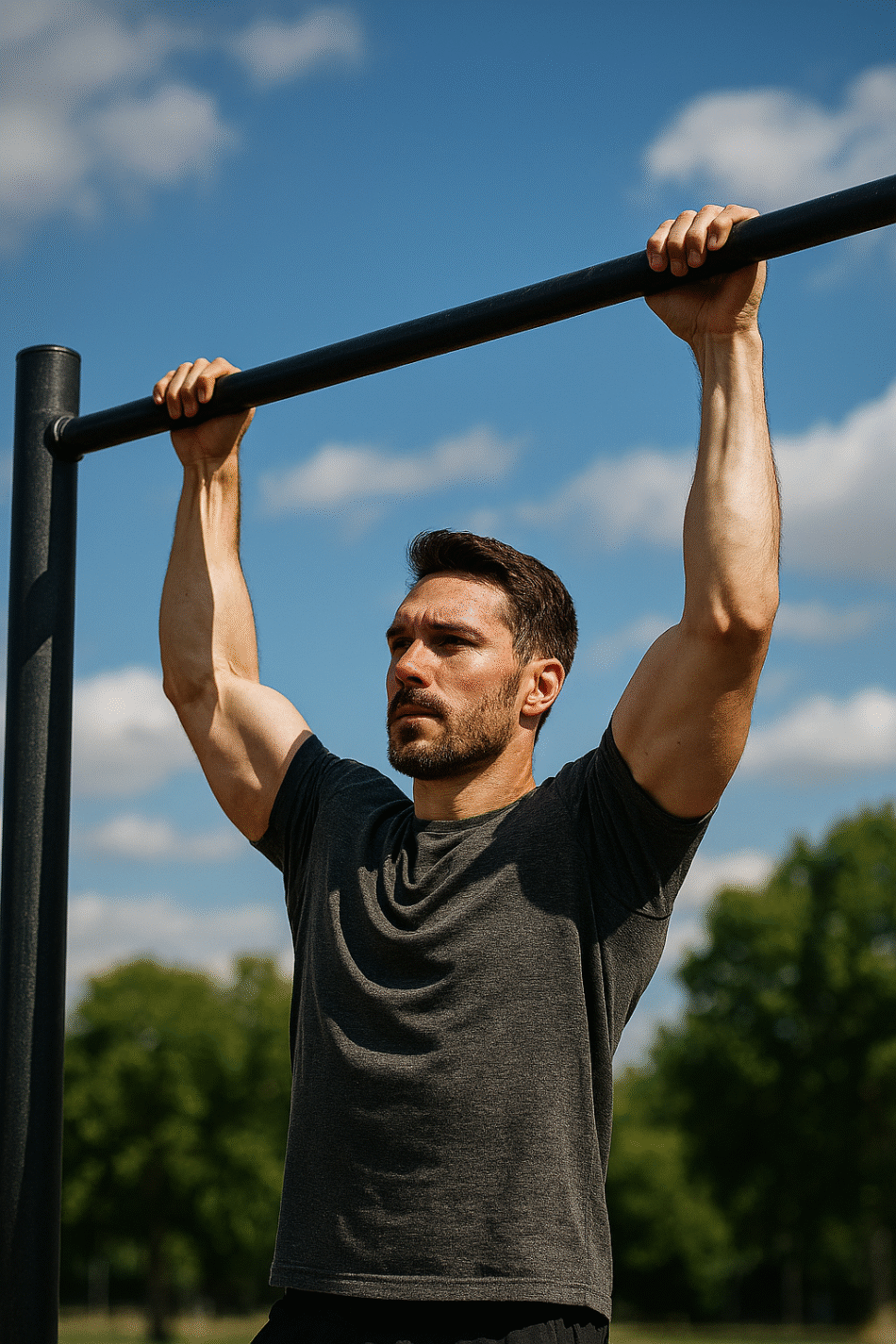Last Updated on October 31, 2025 by shawnshealth
Beginner Calisthenics: Get Strong Without the Gym! Try these simple moves to build strength fast—perfect for beginners.
Introduction to Beginner Calisthenics
Beginner Calisthenics is a simple yet powerful way to build strength, boost energy, and have fun! It might sound like a modern workout trend, but it’s actually one of the oldest forms of fitness—and perfect for beginners. Unlike heavy weightlifting or complex equipment, calisthenics relies on body weight, making it accessible and effective for all fitness levels. Let’s dive into five powerful beginner calisthenics moves to build strength fast!
Author’s Note: Don’t fall for the notion that you can’t have great success with calisthenics. I have personally worked with calisthenics for years and have been asked frequently, “do you lift weights?” The answer is, “Yes I do lift weights. My body has weight, and I use various forms of leverage to get a great strength workout.” It’s very true. You can do great things for your health, fitness, strength, and muscle with some simple calisthenics’ movements. Get in there and start.
👉 Want the full blueprint? Don’t miss The Ultimate Guide to Calisthenics—a complete walkthrough of bodyweight strength, mobility, and progression. Perfect for beginners and advanced athletes alike.
🛒 Quick Tip: Looking for fitness gear? Browse top-rated equipment on Amazon to power up your workouts fast 💪
As an Amazon Associate, I earn from qualifying purchases.
Why is Calisthenics Great for Beginners?
- Builds strength, mobility, and endurance without equipment
- Improves body control and coordination
- Reduces injury risk by reinforcing proper movement patterns
- Can be done anywhere, making it highly accessible
- Lays a strong foundation for advanced exercises
Beginner Calisthenics Mistakes to Avoid:
- Poor Form – Increases injury risk and limits progress
- Skipping Warm-ups – Reduces flexibility and performance
- Not Training Consistently – Slows down strength gains
- Holding Breath During Exercises – Decreases endurance and power
- Progressing Too Fast – Leads to burnout or injuries
What are Primary Muscles Worked and Benefit of Calisthenics Exercises?
| Exercise | Primary Muscles Worked | Benefit |
|---|---|---|
| Push-ups | Chest, Triceps, Core | Upper body strength |
| Horizontal Pulls | Back, Biceps | Builds pulling strength |
| Bodyweight Squats | Quads, Glutes, Core | Lower body power |
| Plank Holds | Core, Shoulders | Improves core stability |
| Glute Bridges | Glutes, Hamstrings | Strengthens hips & lower back |
Table of Contents
Medical Disclaimer: This content is for informational purposes only. Consult a healthcare professional before making any health or fitness changes.
Amazon Affiliate Disclaimer: As an Amazon Associate, I earn from qualifying purchases.
Why Start with Beginner Calisthenics?
Starting a fitness journey with calisthenics has many perks, especially for beginners. It’s simple, doesn’t require any equipment, and builds a solid foundation for body control and functional strength. Whether you’re looking to tone your muscles, improve mobility, or work toward more advanced moves, calisthenics is the ideal place to start.
Video: from Saturno Movement
🎥 Watch This: Check out this video from Saturno Movement featuring accessible calisthenics skills you can start with early on. It’s a great visual guide to foundational movements—but remember, mastering the basics is key to long-term strength and mobility.
The Moves
1. The Push-Up
One of the most well-known calisthenics exercises, the push-up is your ticket to building upper body and core strength. Plus, it’s incredibly versatile! You can adjust your hand placement, range of motion, and even elevate your feet to add challenge.
🧠 Curious why calisthenics is such a powerful tool for your health? Read this article from Verywell Health on the benefits of calisthenics—from boosting strength and flexibility to improving posture, brain health, and bone density
How to Do It
- Start in a plank position, hands shoulder-width apart.
- Lower your body slowly, keeping elbows at about a 45-degree angle or closer to your sides.
- Stop just above the floor, then push back up.
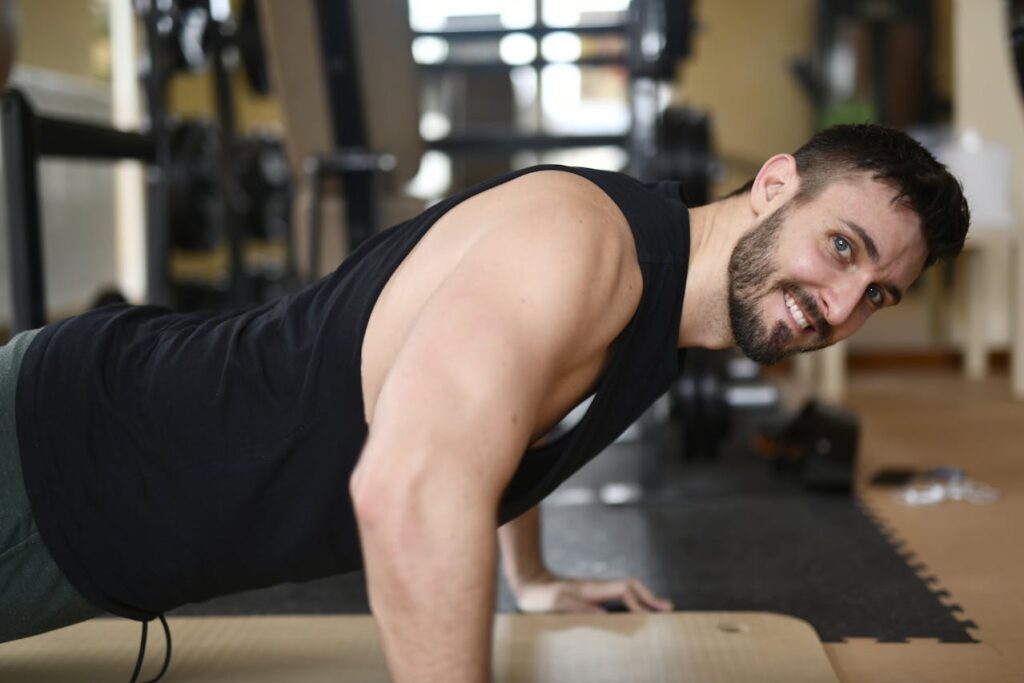
Beginner Tip
If a full push-up feels challenging, start with your knees on the ground. Gradually, you’ll build the strength to move to a standard push-up. And if you’re ready for more, try elevating your feet or adding a clap in between reps.
💪 Want to level up your upper body training? Check out my article on different types of pushups to mix and match into your workout routine—perfect for building strength, adding variety, and progressing safely.
2. Horizontal Pull
In calisthenics, pull exercises are essential for balancing out your push movements. A beginner-friendly pull exercise is the horizontal pull, also known as an “Australian Row.” This move targets your back, biceps, and core, helping to build upper body strength and stability.
How to Do It
- Find a low bar or a sturdy horizontal surface that you can grip.
- Position yourself under the bar, arms straight, feet extended in front of you, with heels on the ground.
- Keeping your body in a straight line, pull your chest up toward the bar, then lower back down.
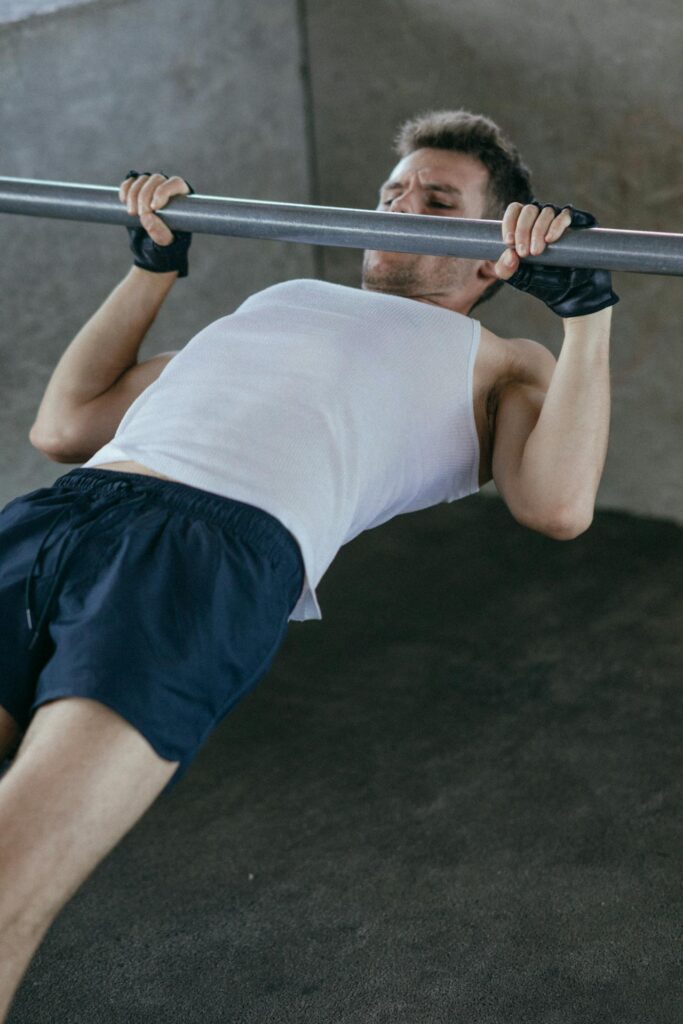
Beginner Tip
If you don’t have access to a bar, you can use a sturdy table or the edge of a desk to perform this exercise at home. Just ensure its stable enough to support your weight. As you progress, try elevating your feet or performing the exercise on lower bars to increase the difficulty.
🧗 Ready to level up your pulling strength? Read my article on unlocking 8 different pullups from beginner to advanced—featuring progressions like Australian rows, eccentric pullups, and one-arm variations to help you build serious upper body power.
3. Bodyweight Squat
When it comes to lower body strength, squats are a must. Bodyweight squats target your legs, glutes, and core, helping you get stronger for everyday activities like walking, climbing stairs, or even dancing.
How to Do It
- Stand with feet shoulder-width apart, toes pointing slightly outward.
- Keep your chest lifted and lower down as if you’re sitting back into a chair.
- Push through your heels to stand back up, squeezing your glutes at the top.
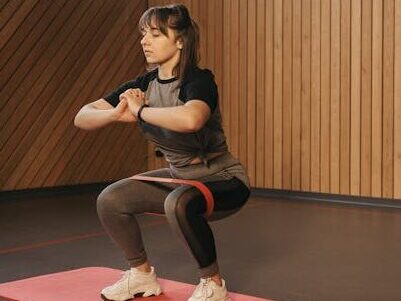
Beginner Tip
Start with shallow squats, gradually increasing your range of motion as you get more comfortable. To add variety, you can experiment with squat pulses or single-leg squats.
🦵 Want to build strong legs without hitting the gym? Check out my article on 7 powerful leg exercises that don’t require weights—perfect for boosting strength, mobility, and endurance using just your bodyweight.
4. Plank Hold
The plank may look simple, but it’s a total-body strength builder, especially for your core. And best of all, you don’t need any special equipment to get started.
How to Do It
- Lie facedown on the floor, then lift your body onto your elbows and toes.
- Keep your back straight, glutes engaged and hold for as long as possible.
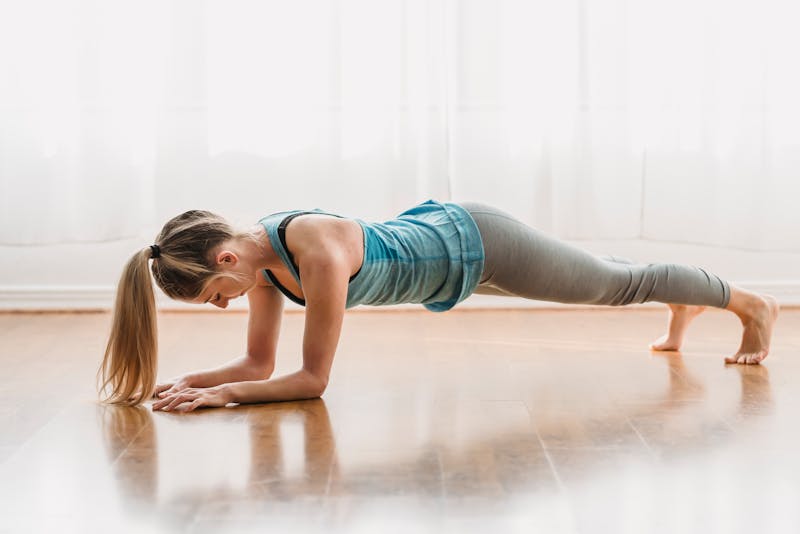
Beginner Tip
If a traditional plank feels tough, try holding the position on your knees instead. Aim for 20-30 seconds at first, then work your way up to one minute or longer.
5. Glute Bridge
A glute bridge is fantastic for targeting your glutes, hamstrings, and lower back. It’s especially helpful if you’re looking to improve posture and counter the effects of long hours spent sitting.
How to Do It
- Lie on your back, knees bent, feet hip-width apart.
- Push through your heels to lift your hips, creating a straight line from shoulders to knees.
- Hold for a few seconds, then lower down with control.
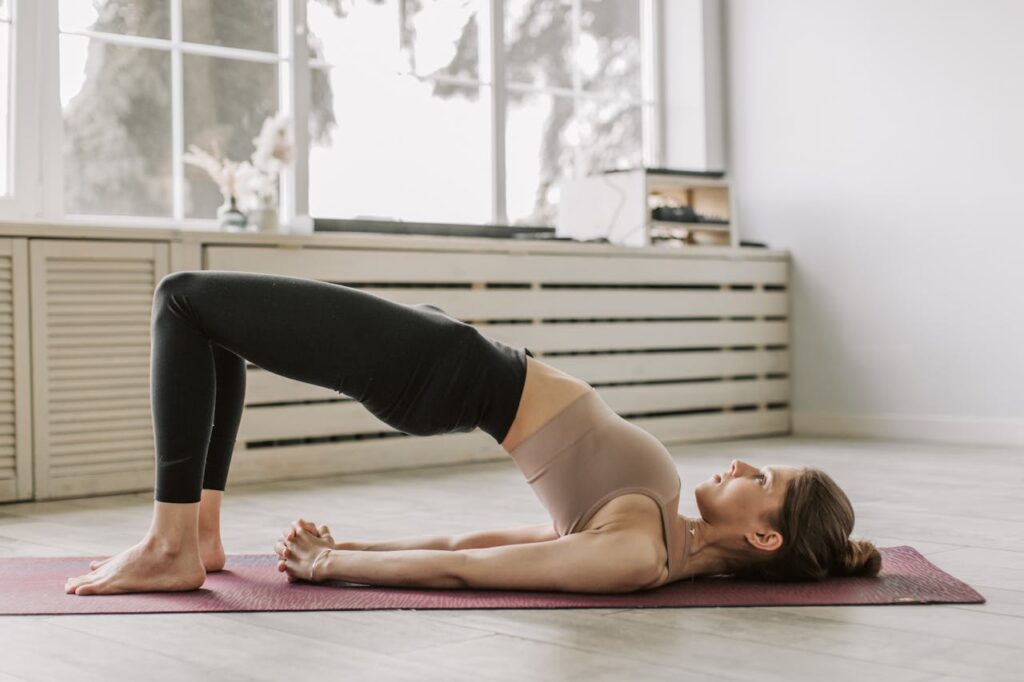
Beginner Tip
Add a few seconds to your hold each time, aiming for 10-15 reps per set. If it feels easy, try lifting one leg at a time to make it more challenging.
Tips for Building a Beginner Calisthenics Routine
When you’re first getting into calisthenics, keep it simple! Start with just 10-15 reps of each exercise (except the plank, which you’ll hold as long as you can) and aim for 2-3 rounds. Rest for a minute between rounds to let your muscles recover. This routine will give you a solid foundation and help you build strength without risking overuse or injury.
🧱 Calisthenics Progression Pyramid
- 🟢 Level 1 – Foundation: Wall Push-Ups, Glute Bridges, Knee Planks
- 🔵 Level 2 – Stability: Incline Push-Ups, Bodyweight Squats, Full Planks
- 🟠 Level 3 – Strength: Standard Push-Ups, Horizontal Pulls, Squat Pulses
- 🔴 Level 4 – Challenge: Decline Push-Ups, Pull-Up Progressions, Single-Leg Squats
Tracking Your Progress in Calisthenics
Tracking progress in calisthenics doesn’t need to be complicated. You can simply note how many reps or seconds you can do for each move, aiming to add a bit more each week. Watching your reps go up is incredibly motivating, especially when you don’t need fancy equipment to see results!
📊 Track Your Progress Week by Week
| Exercise | Sets | Week 1 | Week 2 | Week 3 | Notes |
|---|---|---|---|---|---|
| Push-Ups | 3 | 10 reps | 12 reps | 15 reps | Form improving |
| Horizontal Pulls | 3 | 8 reps | 10 reps | 12 reps | Using lower bar |
| Bodyweight Squats | 3 | 15 reps | 18 reps | 20 reps | Added squat pulses |
| Plank Hold | 3 | 30 sec | 45 sec | 60 sec | Core feels stronger |
| Glute Bridges | 3 | 10 reps | 12 reps | 15 reps | Trying single-leg version |
Calisthenics: A Beginner’s Doorway to Fitness
Calisthenics is more than a workout—it’s a lifestyle. The freedom to train anywhere, the simplicity of using your own body weight, and the power to steadily progress make it perfect for beginners. Plus, once you’re comfortable with these moves, you’ll have an excellent base for exploring advanced exercises down the line.

Conclusion
Whether you’re aiming to build strength, improve balance, or simply try something new, beginner calisthenics is a fantastic way to start. These six moves provide a full-body workout that’s both challenging and achievable, helping you become stronger and more confident with every rep. So, what are you waiting for? Roll out a mat, grab some water, and let’s get started on this powerful journey into calisthenics!
📘 Want to learn more about bodyweight training? Check out The Ultimate Calisthenics FAQ: Everything You Need to Know About Bodyweight Training for a complete guide—featuring foundational exercises, progression tips, and expert advice to help you get stronger, move better, and train smarter.
🔥 Gear to Help You Achieve Your Health and Fitness Goals 💪
If you’re looking for tools to enhance your fitness journey, check out this. Explore top-rated fitness gear on Amazon to enhance your workouts. Check out the latest picks here! 🛒 to support your workouts and progress.
🚀 Find equipment designed to boost strength, endurance, and overall performance!
⚠️ Short disclaimer: As an Amazon Associate, I earn from qualifying purchases.
FAQ – Beginner Calisthenics: 5 Powerful Moves to Build Strength Fast
1. How often should beginners do calisthenics?
- 3-4 times per week for optimal recovery and progress
- Allow at least one rest day between sessions
- Gradually increase frequency as strength improves
2. Can I build muscle with calisthenics alone?
- Yes, if you apply progressive overload (increasing reps, sets, or difficulty)
- Proper nutrition with enough protein supports muscle growth
- Consistency is key for noticeable gains
3. Do I need equipment for beginner calisthenics?
- No, all exercises use body weight only
- A pull-up bar or sturdy surface can help for horizontal pulls
- A mat can add comfort for floor exercises
4. How long does a calisthenics workout take?
- 20-45 minutes, depending on intensity and rest time
- Shorter sessions (20-30 min) work well for beginners
- Focus on quality reps rather than workout length
5. What should I do if I can’t perform a full push-up?
- Start with knee push-ups or incline push-ups
- Focus on slow, controlled movements for strength building
- Gradually lower the incline until you can do a full push-up
6. How do I progress in calisthenics?
- Increase reps and sets over time
- Use harder variations (e.g., diamond push-ups instead of regular push-ups)
- Reduce rest time between sets for endurance gains
7. Can I lose weight with calisthenics?
- Yes, when combined with a calorie-controlled diet
- High-rep circuits help burn calories and improve endurance
- Adding cardio like jumping jacks or burpees enhances fat loss
Fear not, for I am with you; be not dismayed, for I am your God; I will strengthen you, I will help you, I will uphold you with My righteous right hand. – Isaiah 41:10

